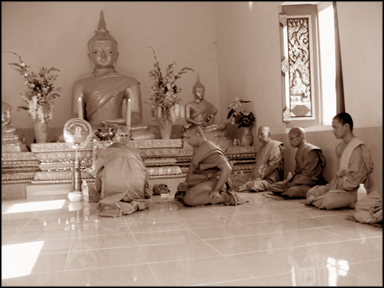Vassana retreat
by M. Herbert FERNANDO from London
 The Vassana Retreat signifying the Vas Aradana and the Katina
Pinkamas, all commenced from the time of the Buddha. The Vassana Retreat signifying the Vas Aradana and the Katina
Pinkamas, all commenced from the time of the Buddha.
In India, the birthplace of the Buddha, there were three seasons in
the year, namely the Hemantha, Gimhana and the Vassana respectively.
The Vassana season generally known as the rainy season commenced in
the month of July also called the month of Esala, and concluded in the
month of November known as the month of Il.
During the rainy season, the disciples of the Buddha came across
difficult situations especially whilst going on their Pindapatha rounds.
The Buddha, who was appraised of this situation by his disciples, very
carefully considered the request by His disciples and granted permission
that they reside within the temples and monasteries during this three
month period. The Buddha also expected that the lay supporters would
very kindly look after the welfare of his disciples during this period.
In Sri Lanka according to Buddhist history it was only after the
arrival of the Most Venerable Arahat Mahinda Thera that Katina Pinkamas
did commence in the Sacred City of Anurahdapura on the Esala Poya Day.
It is also mentioned that King and Heads of states generally not only
sponsored, but also facilitated with the assistance of the devotees, to
conduct these Vas Pinkamas. It is also learnt that King Parakramabahu,
King Kirthi Sri Rajasinghe and King Rajadhi Rajasinghe, younger brother
of the King Kirthi Sri Rajaisnghe conducted these Vas Pinkamas during
their times of reign in Sri Lanka.
The three month Vassana period also afforded the clergy as well as
the laity to maximise this opportune period in the dispensation,
practising and propagation of the sublime teachings of the Buddha.
It was the practice both in the past and present for Buddhist temples
and monasteries to arrange daily Dhamma sermons and Sil campaigns with
full day religious programs and engage in numerous religious activities,
such as Dhamma discussions, chanting of Pirith, Abhidhamma classes for
the benefit of the clergy and the laity especially during this period.
The Katina Pinkama takes place only once a year, in any one temple or
monastery and that Buddhist devotees anxiously look forward either
individually or jointly to make the offering of the Katina robe to the
Maha Sangha. The demand is immense and that many temples carry a list of
advance reservations made by devotees to offer this katina robe, which
is of course considered an annual event accruing immense merit. The
preparation of the Katina robe is done on the same day the offering is
to be made. Anxious devotees start preparing the robe which has to go
through a number of stages from the very early hours of the morning.
Today it has become a common thing to offer a readymade Katina robe,
it is observed.
The Katina Chivararaya so prepared is brought in a grand procession
carried by the person who undertakes the offering and that this
procession is led by drummers, school children carrying Buddhist flags
and candlelight colourful lanterns, sesath and tours the streets from
the early hours of the morning on the day of the offering to noble most
devotees to catch a glimpse of this rare and spectacular event and
thereby accrue merit, and is also a wake up call to devotees to attend
this ceremony.
The procession enters the temple by about 6 in the morning and that
the offering is made by the Dayaka or Dayika to the Maha Sangha,
comprising the Vassana Monks who observed Vas and are seated in the
order of seniority and in the presence of a very large number of
devotees, also generally attended by the Head of State, Trustees and
Management committee members of the Temple.
The Head Monk then delivers a short discourse on the significance of
the Vassana Retreat and the connected Vas and Katina Pinkamas and the
immense merits accrued by such a rare offering.
At close of this brief ceremony the Vassana Monks retire to meet at
the Simamalakaya, where it is decided as to which Monk would be entitled
to receive Katina robe on that particular year.
The Monk who is offered the Katina robe generally wears it and
delivers a sermon on Katinanisansa.
Mention has also to be made of the Kapuruka, which is open for all
types of offerings of essential items and requisites like medicines,
items of stationery and the like offered for use by the Temple Monks
throughout the year.
It is observed that it is only the Upasampada Monks, Monks who have
received the higher ordination, could avail themselves to observe the
Vassana period and also be entitled to receive the katina Robe.
A Monk who has so observed the three months Vassana period could not
be away for more than seven days from the Temple of observance and that
if he does leave for some valid reason or other, he should return to the
Temple by the seventh day.
A Monk who misses or is late to observe the Vassana period on the Day
of Vas Aradana ceremony would be permitted to observe the late-Vas
termed pasu-Vas and that such a Monk would not be entitled to receive
the Katina robe or Katina Chivaraya.
By courtesy of the Vajirarama library are a few pictures in sequence
order of a Katina ceremony held at the Vajirarama Buddhist Temple,
Bambalapitiya, in Colombo in the mid sixties.
|

